CHAPTER 7
IRIDESCENT SILICA
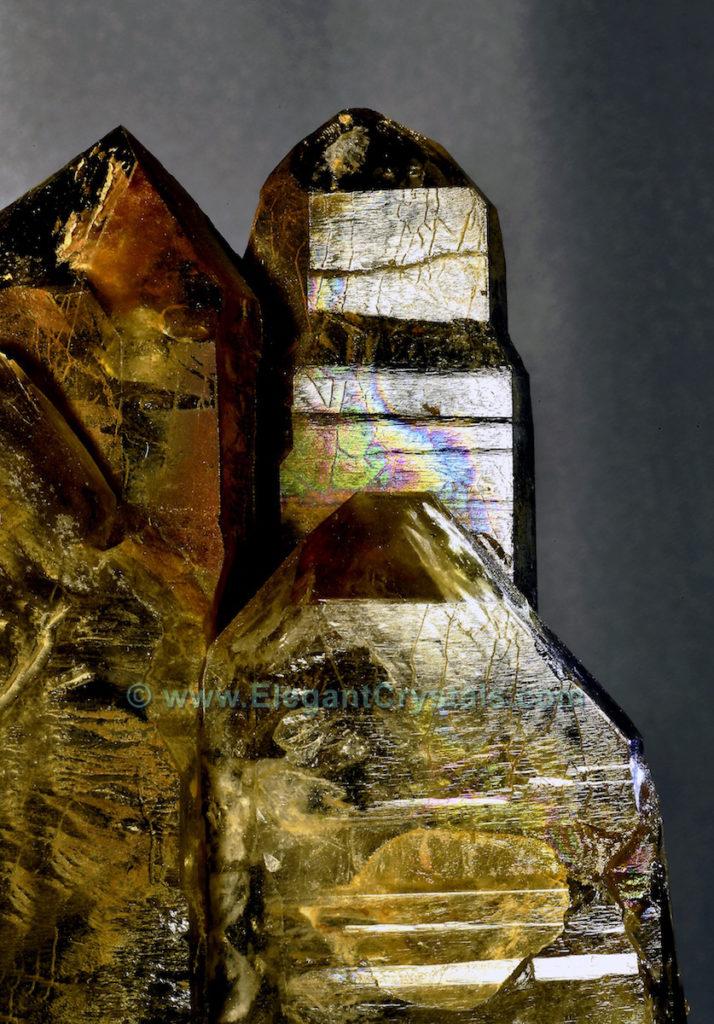
Picture #106
12-inch-tall Smoky Quartz Crystals
from Brazil with Iron Coating
Do rainbows change on the surface of a rock, or inside a crystal?
I usually think of rocks as unchangeable, stable, practically eternal objects.
What could be more durable than something that existed for hundreds of millions of years?
Every rainbow appears to change depending on your angle of view.
More fundamentally, the structures that cause the colors can change too.
The crystal here has a thin coating of iron oxide, maybe even only a few molecules thick.
This layer interferes with light beams, causing spectral colors.
This is the thin film interference effect in action.
This smoky crystal has been water washed, which left the outer colors intact.
If strong chemicals like acids were used to clean this specimen, the iron oxide which causes the rainbow would have been removed.
Most of the time, quartz is soaked in strong chemicals to dissolve and wash away any iron coating.
In this case, stripping would have removed the beautiful iridescent oxide.
Luckily, the miner noticed the lovely delicate coloring, and decided to leave it au naturel.
Fortunately for us, this crystal escaped a drab fate.
Rainbows in quartz fissures can also change if the size of the gap changes.
Check out this amazing phenomenon in the chapter on Living Rainbows.
You can also see the Living Rainbows in motion in my video
Rainbow Secrets of the Crystals on YouTube.
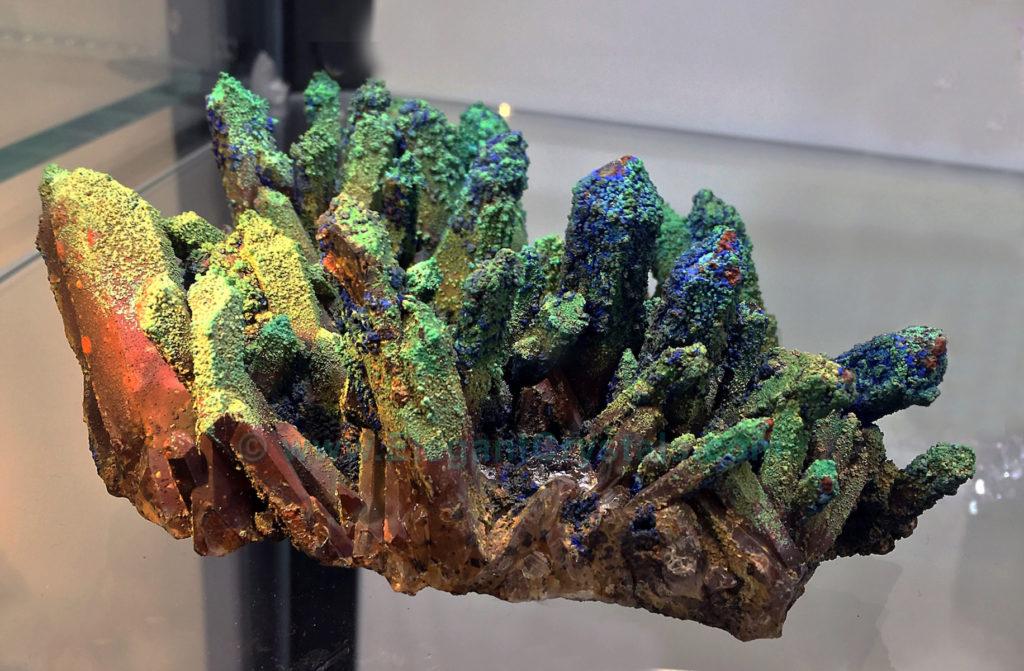
Picture #107
Copper and Iron Coatings on a 4-inch-wide Quartz Cluster
When thin metallic coatings become thicker, they lose their ability to produce “thin-film iridescence.”
In this crystal, the vivid colors are due to pigments, which do not shimmer and change depending on your angle of view.
It would be unwise to clean, scrape or chemically treat a rare find like this.
The cluster’s coating looks so delicate, that I would be wary of holding it, or even touching it.
Nevertheless, these colors have remained intact for millions of years, cushioned in a cavity full of soft, sticky clay.
This specimen was carefully rinsed in distilled water to take off some sticky clay and mud.
Then a special cleaning system, called an ultrasonic vibrating container, used sound waves and bubbles to remove the final layer of mud.
On this mineral, two of the pigments are copper compounds –
azurite (blue) and malachite (green.)
Limonite – a mixture of iron compounds, displays the yellow color.
The orange tints are thin deposits of rust and hematite.
Both those minerals are iron oxides.

Picture #108
8-inch-wide India Quartz Cluster
with Iridescent Facets
Trade Name “Anandalitetm”
At first glimpse, this cluster of tiny quartz crystals does not seem to have any impressive features to recommend it.
The crystal cluster, from India, is called drusy quartz.
Druse, druzy or drusy means “a rock cavity or surface lined with a crust of projecting crystals.”
It is immensely pleasing to my eye, to slowly turn a drusy specimen in bright sunlight.
If the facets are small enough, they can produce hundreds of sparkles per second.
While any cluster of crystals could technically be called “drusy,” in the mineral trade, druse refers to small crystals only.
Yet nobody can officially define the size of a drusy crystal.
I think crystals under 1/2” long, like the ones here, can accurately be called drusy.
Look closely and you will see little flashes of color on this cluster.
Alternating layers of aluminum and silicon-oxide under the crystal’s facets create this rare shimmering iridescent effect.
I always thought each facet showed an individual color, until I created some extreme closeup pictures.
Please take a look at the next three images.

Picture #109
Closeup image of a ¼-inch-long Iridescent Facet
on an 8-inch-wide India Quartz Cluster
Trade Name “Anandalite”
This ¼”-long facet appears green from a distance.
In the highly magnified view here, all kinds of fascinating details show up.
The crystal facet has multiple colors and looks very three dimensional, even though it is essentially extremely flat.
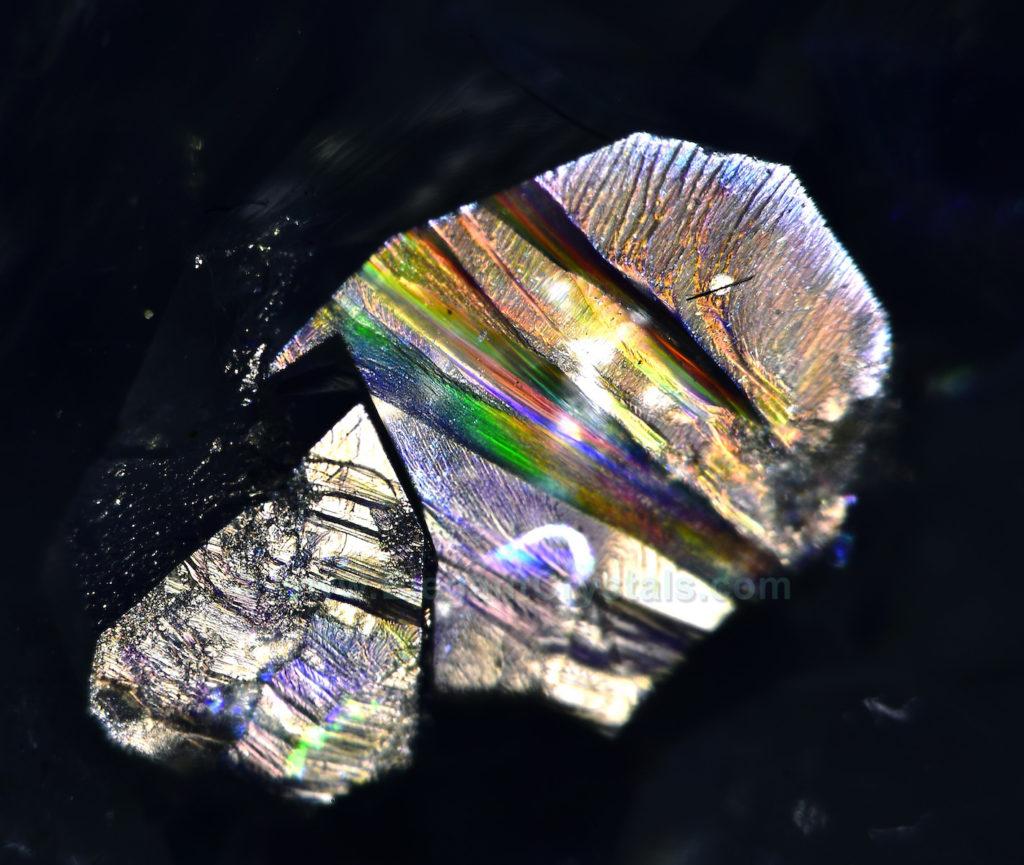
Picture #110
Closeup image of a ¼-inch-long Iridescent Facet
on an 8-inch-wide India Quartz Cluster
This next tiny facet displays an entire rainbow of colors.
The colors are an optical illusion – at most angles, the surface is a clear gray blur.
As the cluster moves in relationship to the light source, the rainbows glimmer briefly and change relative to each other.
I was amazed at the variety of patterns and shades that I saw through my huge magnifying lens.
While all crystals deserve a good close examination, this one took the award for glittering surprises.

Picture #111
Closeup image of a 1/4-inch-long Iridescent Facet
on an 8-inch-wide India Quartz Cluster
Here is one more Anandalite image.
While this one shows some muted colors, the intricate patterns are amazing.
This is the crystal’s “fingerprint,” a distinctive design unique in the world.
Each of the thousands of facets on this cluster has its own marvelous patterns and colors; never repeated, always intriguing.
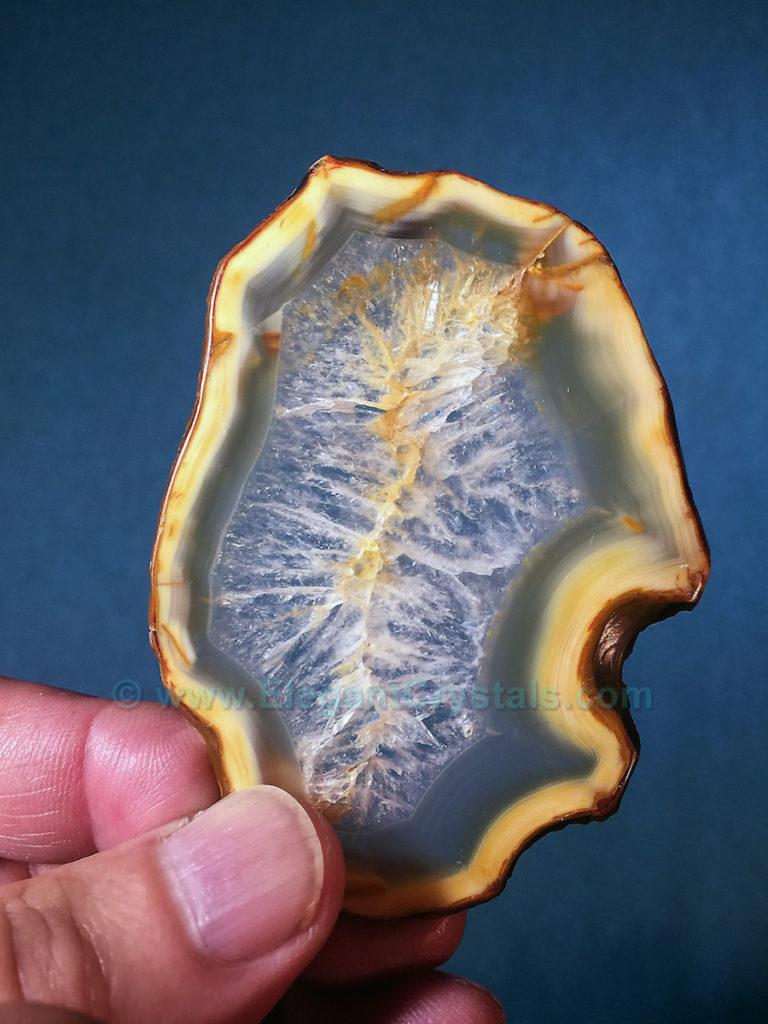
Picture #112
3-inch-wide Iris Agate from Brazil
Agates are colored quartzes with lots of metal oxides interspersed in the atomic structure.
Typical agate colors are gray, white and tan.
Different locales, with unique ground chemistry, can create agates with many mixes of vivid colors.
Agates look like lumps of muddy rock when they first come out of the ground.
After the dirt is washed off, they are still brown-colored on the outside.
Once the stone is sliced into thin sheets, the interior colors become visible as solid or translucent ring shapes.
When the slices are polished, a typical agate will have clear crystals in the middle, surrounded by layers of differing colors.
Occasionally, when an agate is sliced down to 1/8-inch-thick, optical effects create elusive rainbows.
These are known as Iris Agates.
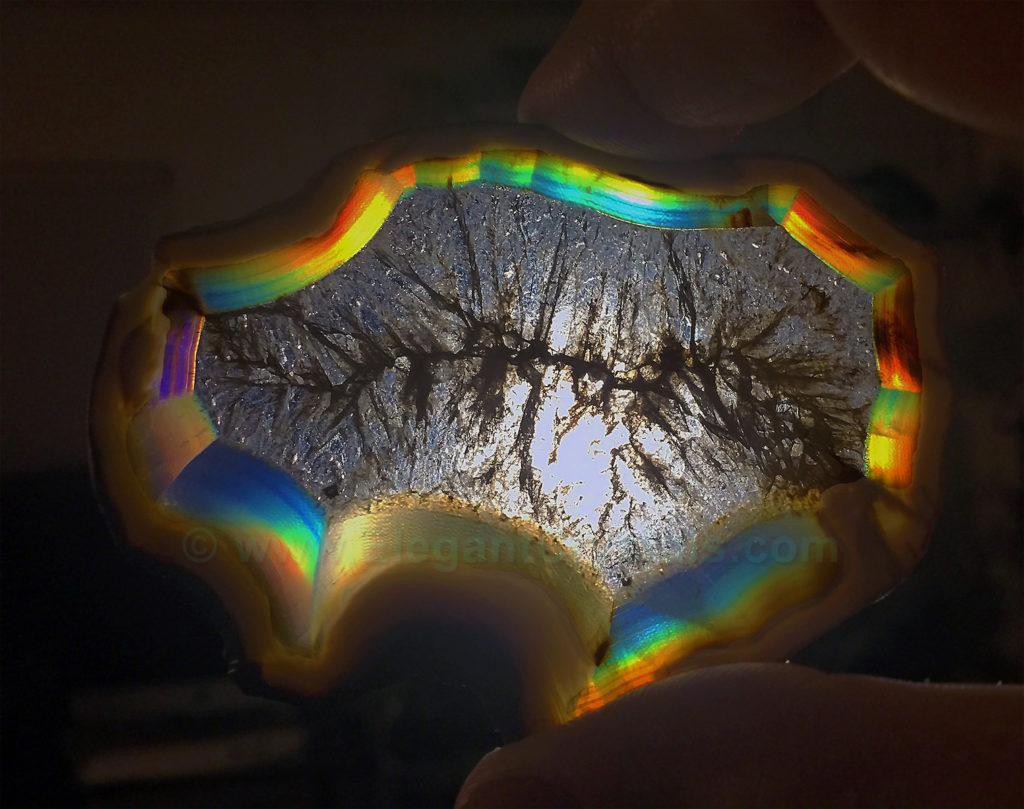
Picture #113
3-inch-wide Iris Agate from Brazil
Here is an image of the same agate with back lighting instead of front lighting.
This 1/8”-thick agate slice acts like a diffraction grating.
The thin multiple layers of quartz bend and blend white light into ever changing rainbows.
The full spectrum of colors can best be seen when a spotlight is placed 10-15 feet behind the stone.

Picture #114
3-inch-wide Iris Agate from Brazil
As the light source moves closer to the crystal, each slice takes on its own breathtaking and distinctive color palette.
Swirls of pure color change their locations as you move the stone.
A close look at these pictures reveals repeating ripples in the agate.
These multiple growth layers started at the outside of the pocket/cavity, and then gradually extended into the interior as the stone cooled, solidified, and crystallized.
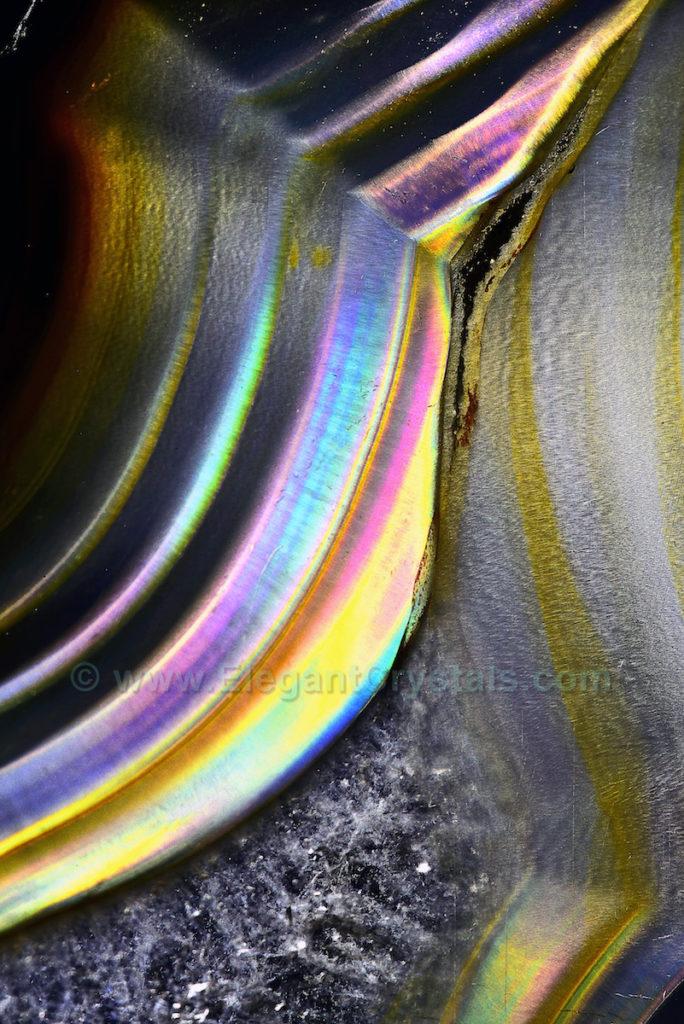
Picture #115
3-inch-wide Iris Agate from Brazil
This highly magnified view shows the layers taking on more and more dimensionality and color variation, no matter how close we get.
A microscope view would also yield images with ever expanding, never repeating colors.
The iris agate is a natural hologram structure, with no limits to its color varieties.
Iris agates are rare.
Only one out of thousands of stones show these types of colors when they are thinly sliced.
The rarity bumps the price way up.
An iris agate may cost 50 times or 100 times more than a regular agate slab was worth.

Picture #116
3-inch-wide Iris Agate from Brazil
Note the crystallization inside the agate layers.
These are individual quartz crystals, packed into the interior.
The crystals here have solidified into a clear mass within the tan agate.
Other agates may have hollow spaces inside.
This makes them more fragile during cutting and handling.
Note the tiny stippled patterns near the edges.
You can almost see the molecules stacking up into layers.
I think I can safely say that all transparent and translucent stones have visual treats and surprises in them.
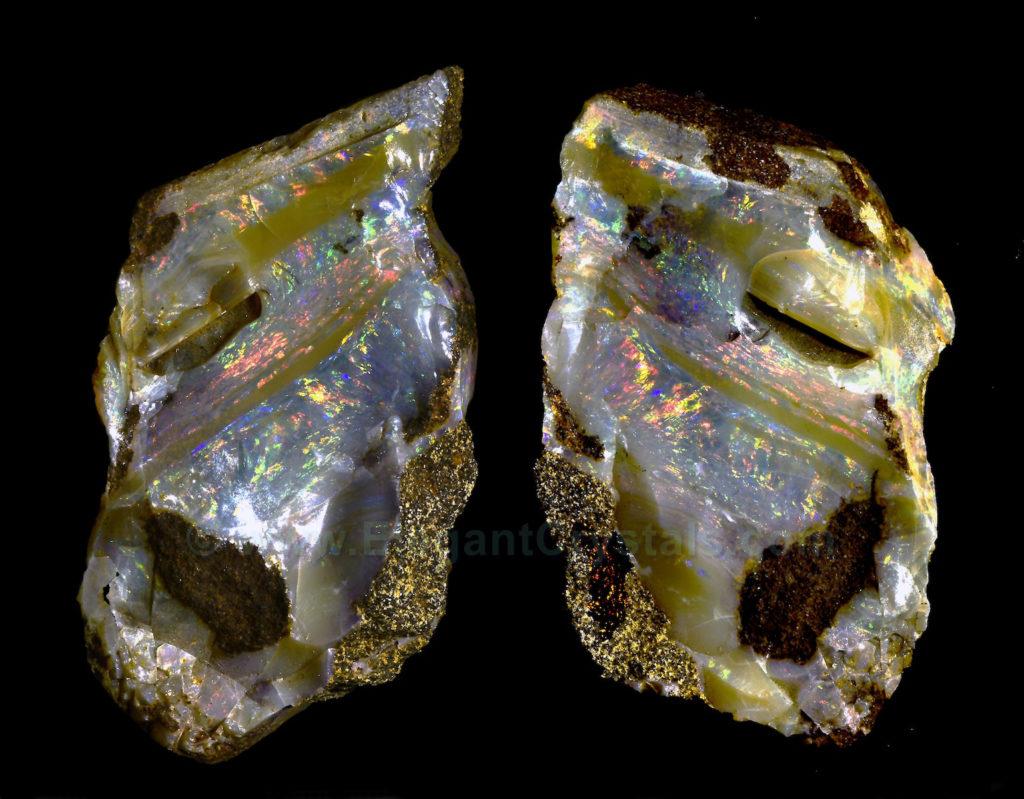
Picture #117
Pair of 3-inch-wide Opals from Australia
These giant opals fit together perfectly.
The opal layers solidified between two layers of “iron stone,” the typical matrix rock in Coober Pedy, Australia.
When the gem was mined, it split in half with almost identical mirror images.
A skilled crystal cutter sliced away the excess brown rock, leaving a pair of gems that remind me of iridescent butterfly wings with eye spots.
In the next picture, the same opal shows beautiful undulating patterns of growth.
A miniature river of liquid opal deposited its silica molecules in a rocky crack that was thinner than 1 millimeter.
At the low temperature and pressure of opal formation, the silica creates microscopic crystal balls, floating in a watery matrix.
These tiny globes act like the raindrops in the sky that create vivid rainbows.
The opal compound is called hydrated silica.
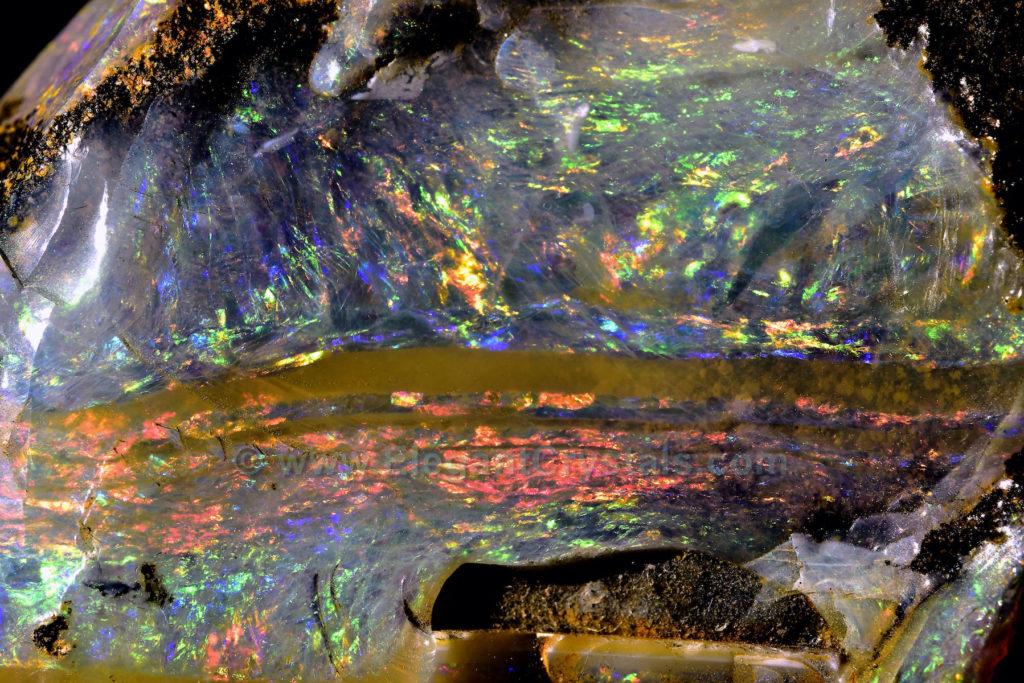
Picture #118
Closeup Photo of a 3-inch-wide opal from Australia
Each microscopic crystal ball beams its colors through transparent water held in place by the opal matrix.
Oily coatings can help slow down the evaporation of an opal’s water.
If opals dry out too much, the color disappears, much like in dried abalone shells.
You can prevent this with a little olive oil rub, or wear the opal gem next to your body where skin oils will help keep it hydrated.
A basic protective measure involves rubbing the stone between your fingertips to help spread a little oil around.
The size of the opal spheres is in the same size range as the raindrops that glow in the sky.
If the watery drops in the sky, or the tiny crystal balls in the opal get too large or too small, the colors will instantly disappear.
The loss of colors is called “white potch” in the case of opals, and a “white fogbow” in the case of aerial moisture.
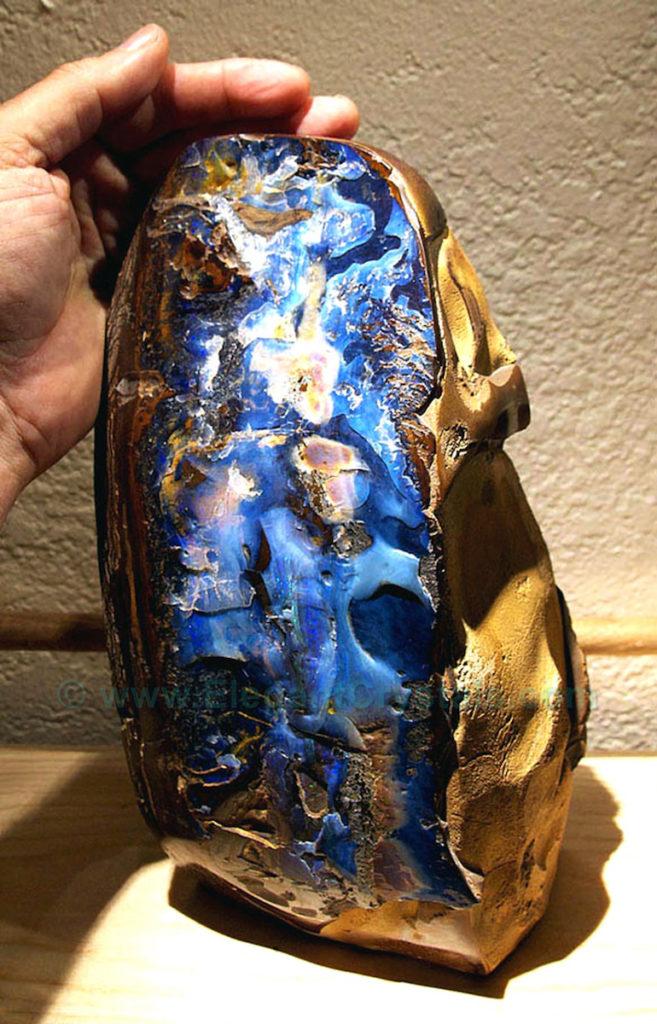
Picture #119
8-inch-tall Australian “Boulder Opal” in Ironstone Matrix
This is the second largest chunk of opal I have ever seen.
I couldn’t afford the price tag on the biggest one, 12-inches-long, but this one suited me fine.
I like the blue hues, my favorite colors.
Threads and pools of bright rainbows floated in what appeared to be oceanic waves.
The bottom was flat enough to let it stand up tall.
I always like to have my big stones displayed vertically to appreciate their full majestic nature.
I think the energy of the vertical stones helps to connect Heaven and Earth in my life and home.
When I got this stone, I was young and naive.
I thought it was a solid chunk of opal, 4-inches-thick.
The back of this boulder opal has another beautiful sheet of vibrant colors, just like the front.
This made me believe I had a solidly-colored stone.
My plan was to cut a series of thin slabs
that I could turn into an opal-glass rainbow window, which could sell for big bucks.
Then a lapidarist told me opal only grows in thin sheets in cracked rocks.
In retrospect, I am glad we didn’t try to slice up this handsome specimen.
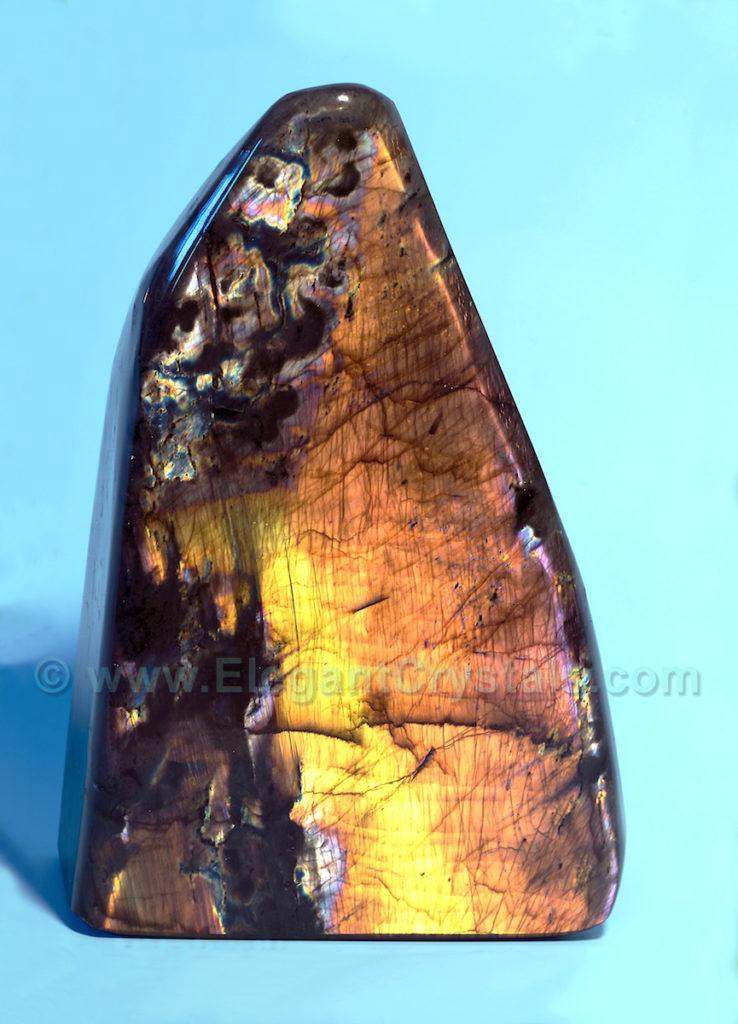
Picture #120
7-inch-tall Polished Labradorite from Madagascar;
Chemical Formula – (Ca, Na)(Al, Si)4O8)
Calcium-sodium-aluminum silicate
This complicated metallic silicate is basically clear quartz with mirror-like sheets of three different metallic atoms that create the color effect.
The ratio of the metals determines the depth and tint of the stone.
Originally found in small batches in Labrador Province, Canada, most of the world’s labradorite (trade name- Spectralitetm) now comes from the giant island of Madagascar, situated just east of Africa.
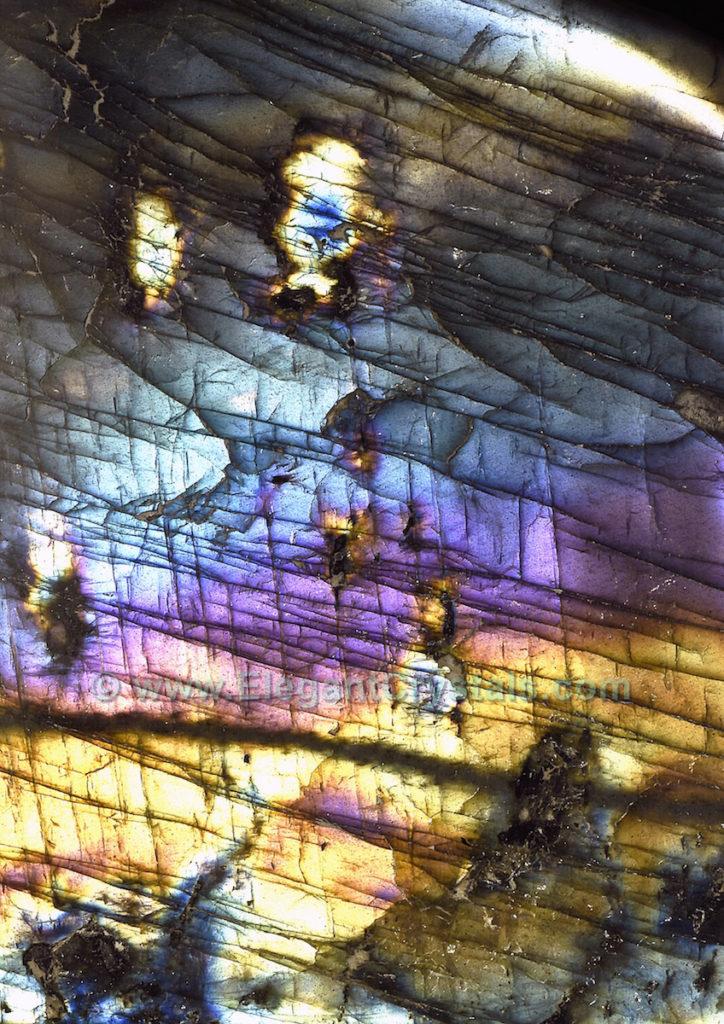
Picture #121
Madagascar Labradorite: Closeup Image
This lovely type of stone is found in Canada, Madagascar and Finland.
It only forms in certain types of feldspar that cooled very slowly, allowing the metallic atoms to migrate into layers that act like mirrors.
Spectralitetm is a type of feldspar related very closely to moonstone.
While moonstone occasionally forms faceted “adularia” crystals in the ground, labradorite never creates faceted crystals, but always grows as large boulders.

Picture #122
6-inch-tall Labradorite Buddha Carving from India
The phenomenon that produces labradorite’s iridescence was given its own name – labradorescence.
In the Buddha carving, the blue light glows because of “schiller” effects; the scattering of blue light by tiny particles in the stone.
This mineral is occasionally inaccurately called black moonstone or opaline feldspar.
Large pieces of labradorite are sometimes cut and polished into high end counter tops and tiles.
Blue and yellow tints are the most common displays in labradorite.
More rarely, pinks, peach blush and violet may occur in small areas.
The full spread of the spectrum rarely presents in one polished specimen.
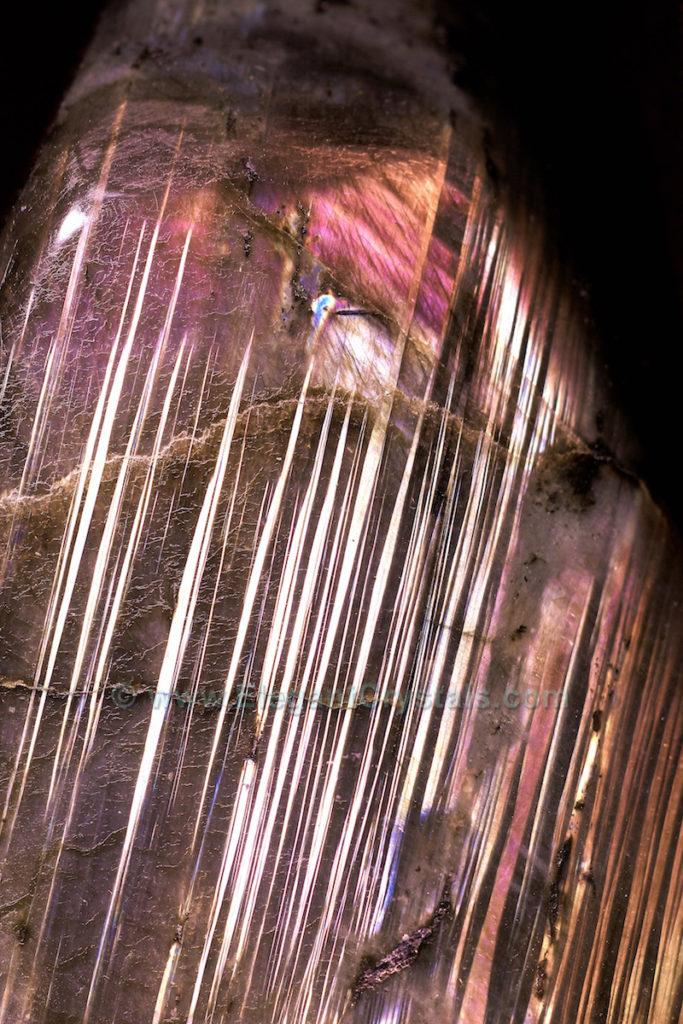
Picture #123
8-inch-long Polished Labradorite from Madagascar
Note the consistent coloring in this rosy piece.
I seldom see large areas with nice uniform colors.
Both the colors and the brilliance of the reflection change at different viewing angles.
Raw pieces of labradorite do not show up in stores, as the color play does not appear until the stone is polished in the correct plane of reflection.
The unpolished pieces just look dark gray, with hints of colors peeking out from small areas.
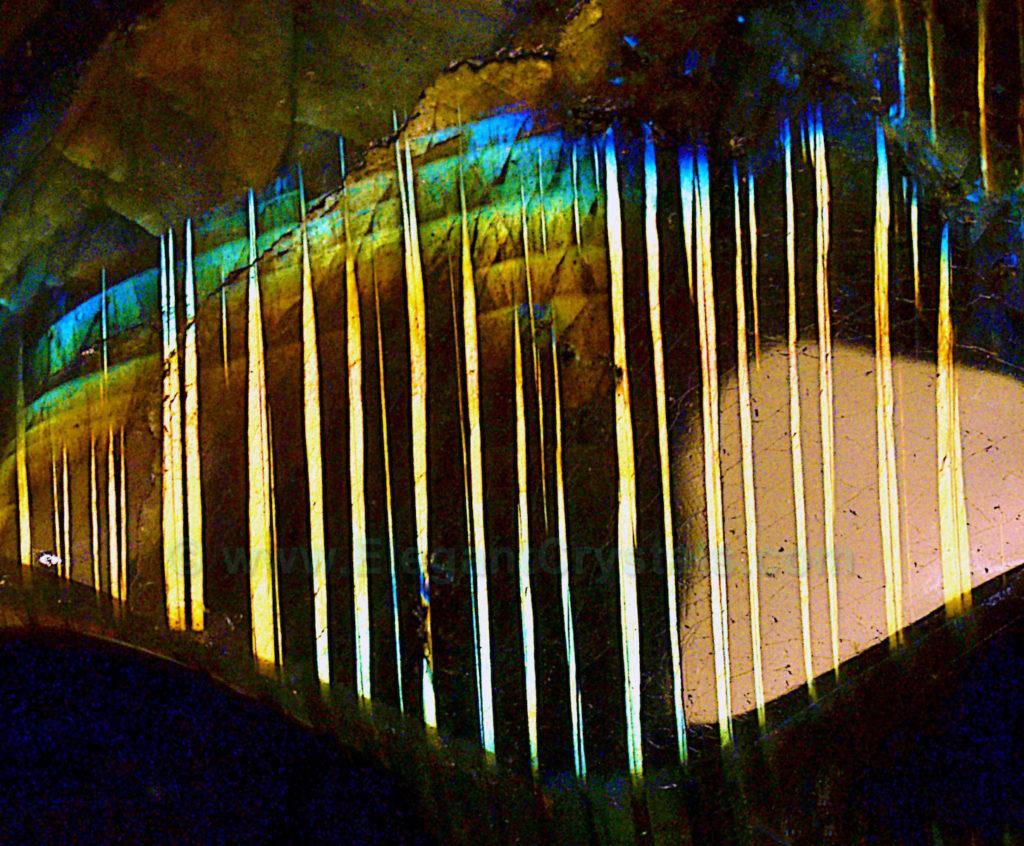
Picture #124
Close-up Image of Polished Madagascar Labradorite
A typical polished piece of this material can look very three-dimensional despite not having any particular clarity.
The unusual glossy slab pictured here shows how closely related labradorite is to clear quartz.
In between the color bands are clear quartz zones going over 1/2” into the crystal.
These clear zones are pure silica quartz.
Other deeper reflective layers (blue-green) contrast in color and angles to the repetitive yellow streaks.
The juxtaposition of layers yields an Escher-like perspective effect that is colorful and mysterious at the same time.
Occasionally, this type of clear-zoned stone will have full spectrum iris rainbows amongst the labradorite streaks.
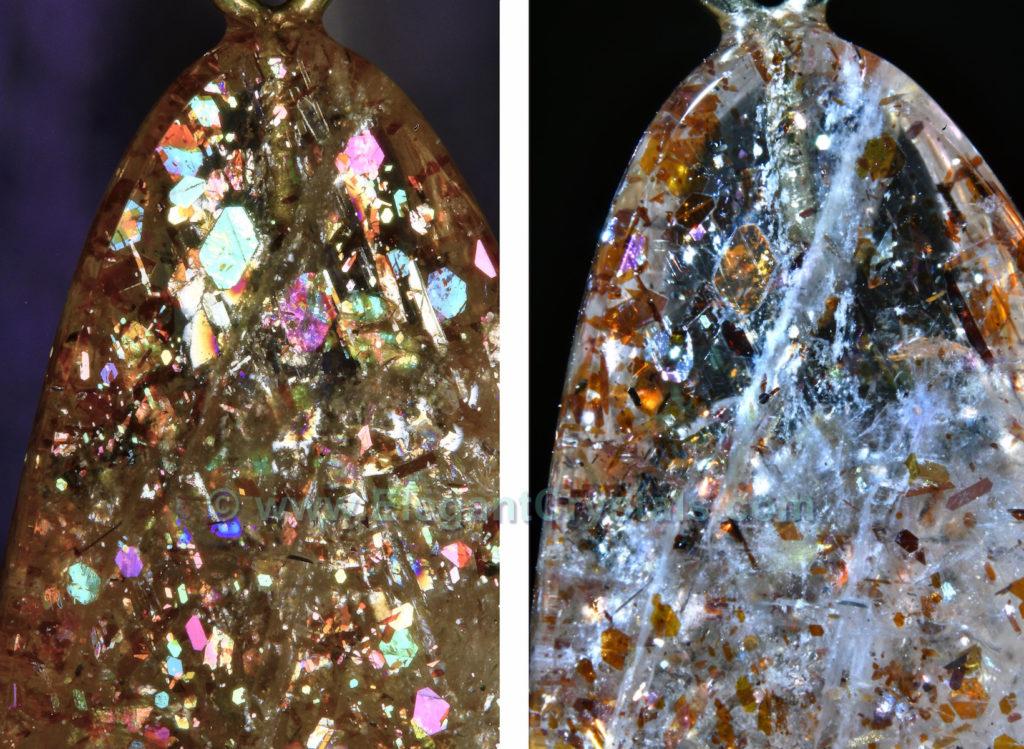
Picture #125
2-inch-long Specular Sunstone, Confetti Sunstone
from Chelyabinsk Oblast, Russia
Design by Bernice Straub
This unusual material is only found in one place on the earth’s surface.
Other kinds of sunstones, with different colors and patterns occur in some 6 other locales scattered around the planet.
The Russian material looks like clear quartz, with small six-sided crystals inside.
These are very thin and flat tabular crystals.
The inclusionary crystals can be pure copper oxides or iron oxide with iron hydroxide (limonite).
The two pictures here show the crystal with front lighting on the left, and backlighting, transmitted light, on the right.
The coppery colors are the “real colors,” similar to pigmented colors in paints.
The multi-colored hexagons are “structural colors” generated by the thin film interference effect in tiny flat crystals.
Those colors change with the viewing angle.
Each little crystal is different from its neighbors.
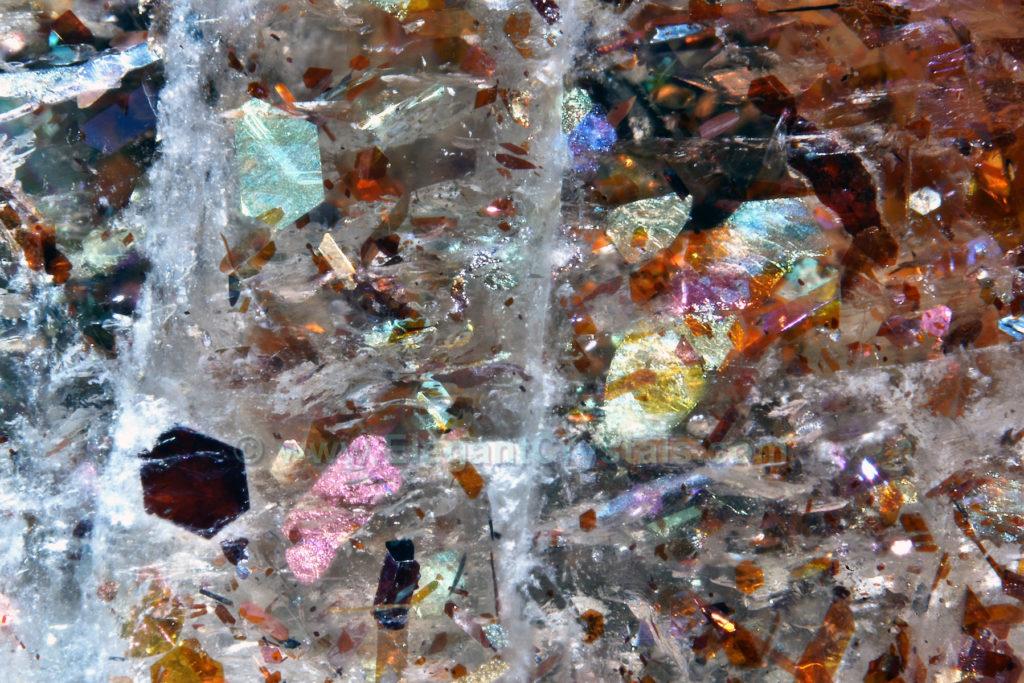
Picture #126
Detail, 2-inch-long Specular Sunstone
from Chelyabinsk Oblast, Russia
Confetti Sunstone
This extreme closeup image of Russian sunstone shows a combination of front and back lighting.
The tiny back-lit coppery crystals are quite clear, despite their dark colors.
They brighten up considerably when front lighting turns them into festive mirrors with wonderful pastel hues.
From a distance, this large jewelry pendant has more “flash” than any other stone I have seen.
Sunstone is another type of feldspar, sometimes called gem microcline.
It is closely related to moonstone and labradorite.
The varieties of colors in the stones depend primarily on the amount of calcium in them.
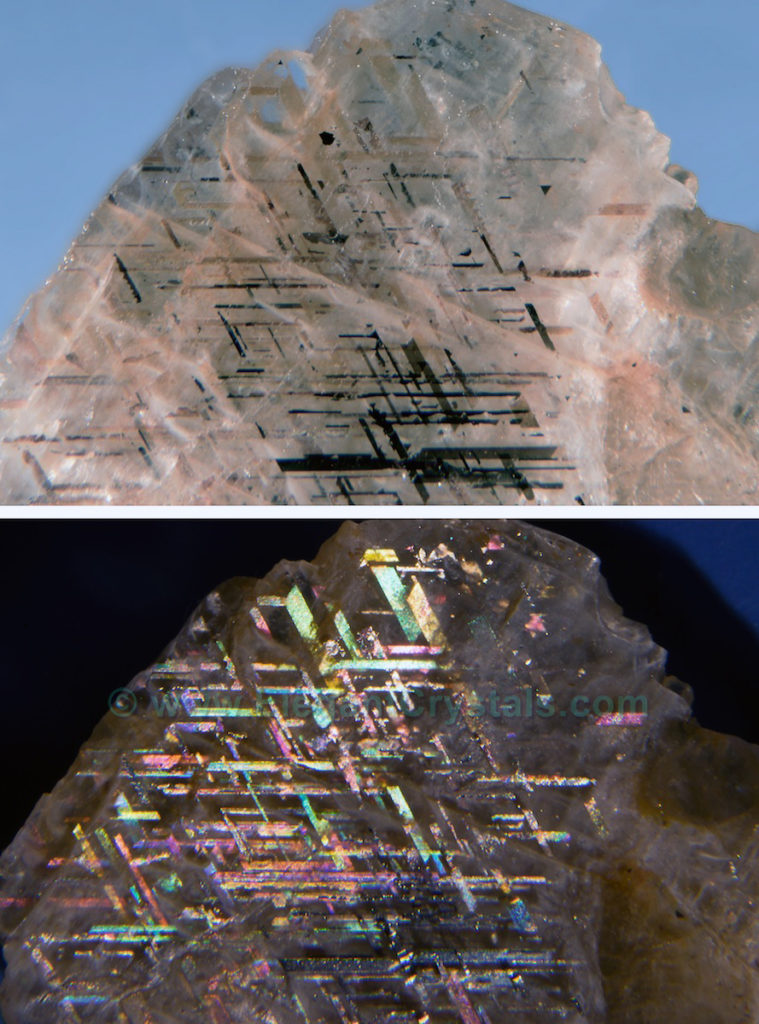
Picture #127
Rainbow Lattice Sunstone
2-inch-wide Reticulated Sunstone from Australia;
Courtesy of Cynthia Carter
This rare item costs hundreds of dollars, or more, for a small slice.
One side was polished flat to best show the patterns.
In this pair of pictures, the stone was kept immobile; only the light changed position.
What a dramatic transformation!
This is clearly an angular phenomenon where the colors can only be seen under specific conditions.
The black streaks are magnetite crystals, made of magnetic iron oxides.
Hematite crystal inclusions yield a sparkly effect in addition to the organized color streaks of the magnetite.

Picture #128
Detail from a 2-inch-wide Reticulated Sunstone from Australia
Rainbow Lattice Sunstone
The world’s supply of gem quality lattice sunstone is found in a 1500-foot by 2000-foot rectangular area in the Northern Territories of Australia.
This unique material was first discovered in 1985.
Every year, a few new types of stones and crystals are identified on our planet.
There are over 4000 mineral and crystal species found to date.
You never quite know what you can find under your feet until you start digging.
These sunstone gems come from the Mud Tank Zircon Field.
This is located in the Harts Mountain Range, Australia’s Northern Territory.
The illusion of dimensionality is outstanding in lattice sunstone.
Like labradorite, the color streaks are alternating with clear zones of crystalline feldspar.

Picture #129
1-inch-long Polished Cabochon of Scapolite from Brazil
(Na,Ca)₄(Al,Si)₃Si₆O₂₄ )(Cl,CO₃)
Cabochon-shaped jewels (cabs) are relatively easy to cut and polish compared to flat-faceted stones.
A skilled gem cutter can create a finished piece like this is less than 30 minutes.
Starting with an irregular chunk of rock, or a badly broken crystal, the lapidarist will cut a flat parallel slab, then polish one side for the back/bottom.
The top of the stone is cut into a dome to create a lensing effect that will magnify whatever patterns are inside.
This scapolite group mineral is a variety of silica that contains proportions of 6 to 10 constituent metallic compounds.
The complex ratios of the metal ions determine the specific name of the crystal and also its optical qualities.
This image of a yellow/tan scapolite cabochon shows density layers that act like micro-mirrors.
The strong color banding only shows up at one specific angle.
I did not move the crystal during the photography.
One little spotlight moved around to create the color flash.
The list of color effects in quartz-type silicates is practically endless and ever-expanding.
These amazing phenomena all depend on light rays bouncing around within tiny structures.
The layers are typically 75% shorter/smaller than the length of the light ray.
In other words, the structures are typically 1/4 wave-sized.
Here are a few of the optical and energetic characteristics of quartz stones that you can explore in your spare time.
Adularescent
Asterism
Aventurescence
Birefringence
Chatoyancy
Dichroicism
Double Polarizing
Double Refraction
Fluorescence
Iridescence
Labradorescence
Lasering
Luminescence
Opalescence
Phosphorescence
Photochromism
Photo-electricity
Piezo-electricity
Pleochroicism
Polarizing
Radio-electricity
Reflective
Refractive
Schiller Effect
Sono-electricity
Tenebrescence
Thermo-electricity
Thermo-luminescence
Triboluminescence
This book does not have room to examine them all.
My primary reference sources are
QuartzPage.de
And
Mindat.org
These websites are the real deal – very factual and science minded.
No speculation or commercialism taints the reality of the information they offer.
I deeply respect their professionalism, thoroughness and comprehensive depth of knowledge.
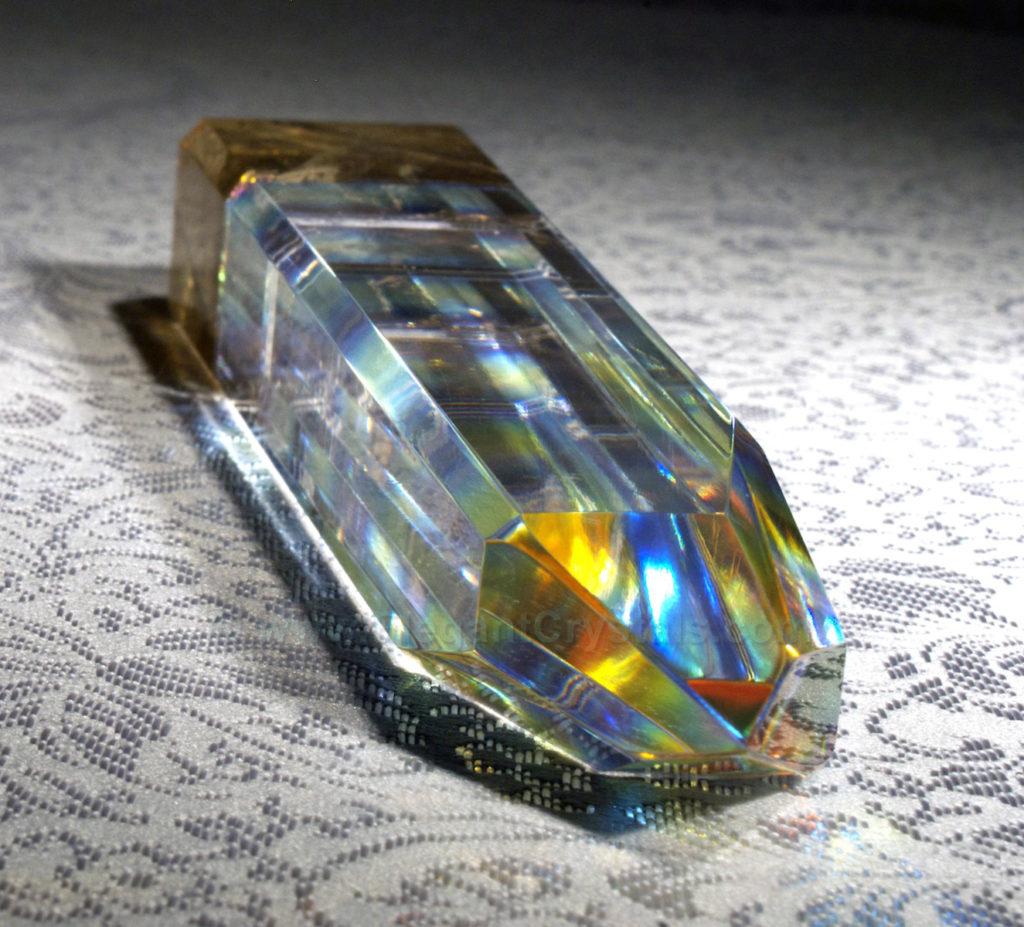
Picture #130
6-inch-long Quartz/citrine/glass Wand by Kings Amao
Artisans and crystal cutters use a variety of materials to create “magic wands.”
Whether or not you believe in the energy powers of stones, these enormous gems, over 2,000-carat-weight, are spectacularly beautiful.
Mr. Amao, one of the world’s top gem cutters from Nigeria, puts together synergistic stones with multi-colored dichroic glass to make shimmering rainbow wands that also act as gem kaleidoscopes.
Note that he has combined two natural materials, clear quartz and golden citrine quartz, with two manmade substances – rainbow dichroic glass and extra-thin layers of special adhesives.
The net result is a piezoelectric/bioelectric healing energy tool that also provides simultaneous chromotherapy (color therapy.)
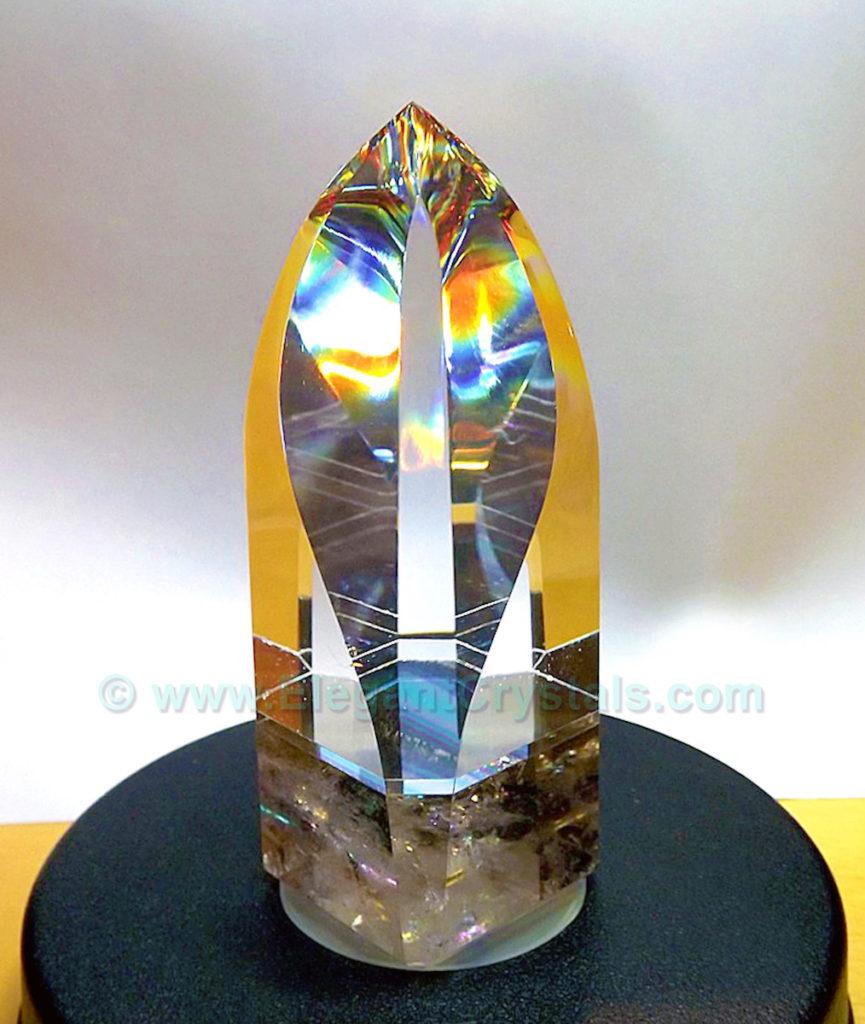
Picture #131
6-inch-long Quartz/citrine/glass Wand by Kings Amao
Most people can sense the electrical energy currents in a quartz crystal.
All it takes, is a little instruction and practice.
This bio-electric ability becomes an important tool in picking out stones for your collection.
Then you can choose gems or crystals based on energy attunement, something that is far beyond pure visual appeal.
I always choose stones that inspire me on some level:
To think better To love better To meditate better
To visualize better
To feel better.
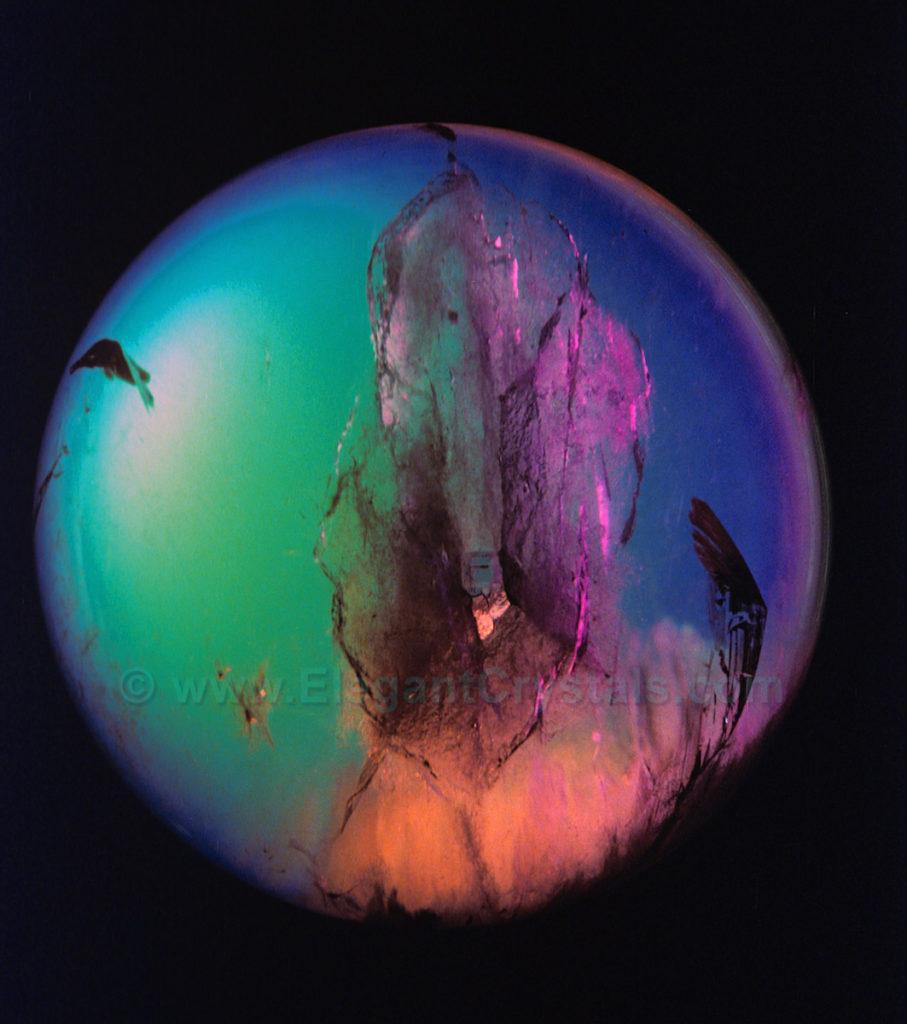
Picture #132
3-inch-wide Clear Brazilian Quartz Ball
with Dichroic Glass Lightbox
Faraway Lullaby
by Cikira
Starlight in crystal
Fixed for all time,
Carry my daughter
A message from me:
If you just listen
Quiet of mind,
You’ll hear your mother
Sing you to sleep.
Star over water,
Travelers’ light,
Cast to your children
A glimmer of me.
Tell them to listen
Deep in the night;
They too will hear me
Sing them to sleep.
Ghost in a crystal,
Light of my life,
Carry close always
A memory of me;
Gently remember
In the still night
How I sat beside you
And sang you to sleep,
Just as my own mother
Sang beside me.
